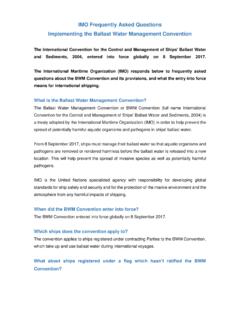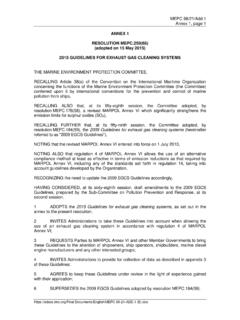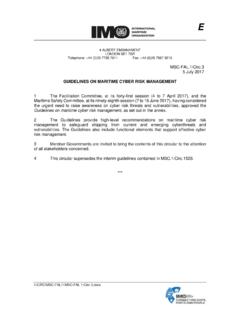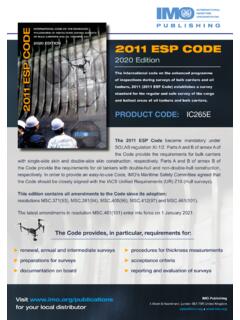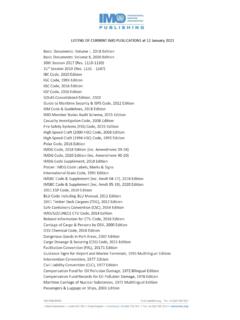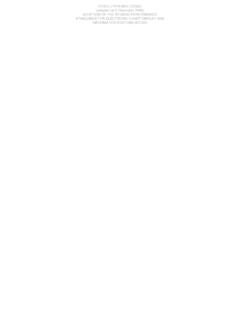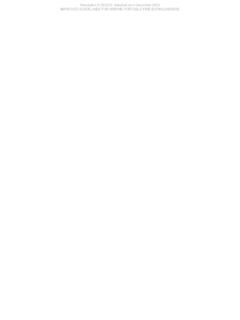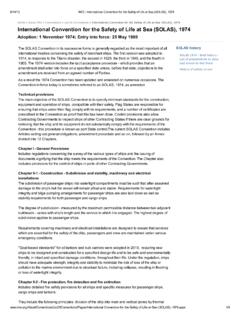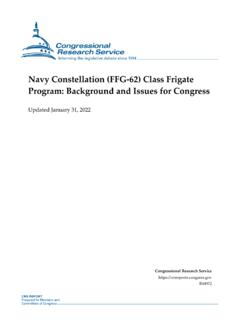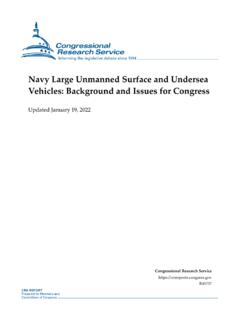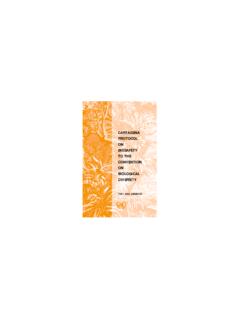Transcription of RESOLUTION MSC.137(76) (adopted on 4 December 2002 ...
1 RESOLUTION (76) (adopted on 4 December 2002) STANDARDS FOR ship MANOEUVRABILITYMSC 76/23 I:\MSC\76\ ANNEX 6 RESOLUTION (76) (adopted on 4 December 2002) STANDARDS FOR ship MANOEUVRABILITY THE MARITIME SAFETY COMMITTEE, RECALLING Article 28(b) of the Convention on the International Maritime Organization concerning the functions of the Committee, RECALLING ALSO that by RESOLUTION (18) the Assembly approved Interim Standards for ship manoeuvrability (the Interim standards), whereby Governments were recommended to encourage those responsible for the design, construction, repair and operation of ships to apply the Interim Standards and invited to collect data obtained by the application of the Interim Standards and report them to the Organization, RECALLING FURTHER that by circular the Committee approved Explanatory notes to the Standards for ship manoeuvrability.
2 To provide Administrations with specific guidance so that adequate data may be collected by the Organization on the manoeuvrability of ships, RECOGNIZING the manoeuvring capability of ships to be an important contribution to the safety of navigation, BELIEVING that the development and implementation of standards for ship manoeuvrability, particularly for large ships and ships carrying dangerous goods in bulk, will improve maritime safety and enhance marine environmental protection, HAVING CONSIDERED the recommendation made by the Sub-Committee on ship Design and Equipment at its forty-fifth session, 1.
3 ADOPTS the Standards for ship manoeuvrability, the text of which is set out in the Annex to the present RESOLUTION ; 2. INVITES Governments to encourage those responsible for the design, construction, repair and operation of ships to apply the Standards to ships constructed on or after 1 January 2004; 3. RESOLVES that the provisions annexed to the present RESOLUTION supersede the provisions annexed to RESOLUTION (18). RESOLUTION (76) (adopted on 4 December 2002) STANDARDS FOR ship MANOEUVRABILITYMSC 76/23 ANNEX 6 Page 2 I:\MSC\76\ ANNEX STANDARDS FOR ship MANOEUVRABILITY 1 PRINCIPLES The Standards for ship manoeuvrability (the Standards) should be used to evaluate the manoeuvring performance of ships and to assist those responsible for the design, construction, repair and operation of ships.
4 It should be noted that the Standards were developed for ships with traditional propulsion and steering systems ( shaft driven ships with conventional rudders). Therefore, the Standards and methods for establishing compliance may be periodically reviewed and updated by the Organization, as appropriate, taking into account new technologies, research and development, and the results of experience with the present Standards. 2 GENERAL The Standards contained in this document are based on the understanding that the manoeuvrability of ships can be evaluated from the characteristics of conventional trial manoeuvres.
5 The following two methods can be used to demonstrate compliance with these Standards: .1 scale model tests and/or computer predictions using mathematical models can be performed to predict compliance at the design stage. In this case full-scale trials should be conducted to validate these results. The ship should then be considered to meet these Standards regardless of full-scale trial results, except where the Administration determines that the prediction efforts were substandard and/or the ship performance is in substantial disagreement with these Standards; and.
6 2 the compliance with the Standards can be demonstrated based on the results of the full-scale trials conducted in accordance with the Standards. If a ship is found in substantial disagreement with the Standards, then the Administration should take remedial action, as appropriate. 3 APPLICATION Notwithstanding the points raised in paragraph above, the Standards should be applied to ships of all rudder and propulsion types, of 100 m in length and over, and chemical tankers and gas carriers regardless of the length.
7 In the event that the ships referred to in paragraph above undergo repairs, alterations or modifications, which, in the opinion of the Administration, may influence their manoeuvrability characteristics, the continued compliance with the Standards should be verified. Whenever other ships, originally not subject to the Standards, undergo repairs, alterations or modifications, which, in the opinion of the Administration, are of such an extent that the ship may be considered to be a new ship , then that ship should comply with these Standards.
8 Otherwise, if the repairs, alterations and modifications, in the opinion of the Administration, may influence the manoeuvrability characteristics, it should be demonstrated that these characteristics do not lead to any deterioration of the manoeuvrability of the ship . RESOLUTION (76) (adopted on 4 December 2002) STANDARDS FOR ship MANOEUVRABILITYMSC 76/23 ANNEX 6 Page 3 I:\MSC\76\ The Standards should not be applied to high-speed craft as defined in the relevant Code. 4 DEFINITIONS Geometry of the ship Length (L) is the length measured between the aft and forward perpendiculars.
9 Midship point is the point on the centreline of a ship midway between the aft and forward perpendiculars. Draught (Ta) is the draught at the aft perpendicular. Draught (Tf) is the draught at the forward perpendicular. Mean draught (Tm) is defined as Tm = (Ta + Tf)/2. Trim ( ) is defined as = (Ta - Tf). is the full load displacement of the ship (tonnes). Standard manoeuvres and associated terminology Standard manoeuvres and associated terminology are as defined below: .1 The test speed (V) used in the Standards is a speed of at least 90% of the ship 's speed corresponding to 85% of the maximum engine output.
10 2 Turning circle manoeuvre is the manoeuvre to be performed to both starboard and port with 35 rudder angle or the maximum rudder angle permissible at the test speed, following a steady approach with zero yaw rate..3 Advance is the distance travelled in the direction of the original course by the midship point of a ship from the position at which the rudder order is given to the position at which the heading has changed 90 from the original course..4 Tactical diameter is the distance travelled by the midship point of a ship from the position at which the rudder order is given to the position at which the heading has changed 180 from the original course.
